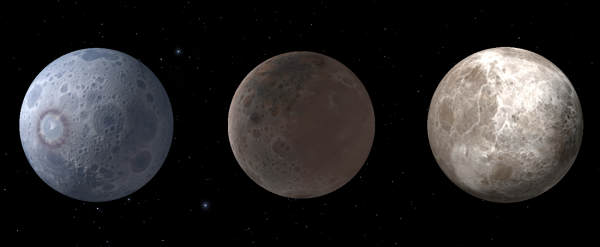BY LETTER
Satellite
 Image from Steve Bowers | |
| Three natural satellites; a LithicGelidian moon (HD 314419 B II), a Selenian moon (Forix I) and a Europan moon (Wuhan) | |
Formation of natural satellites
Natural moons form in several ways. Some are formed from the same collapsing region of the protoplanetary disk that created its primary, others are captured later, either following a grazing collision or by exchanging momentum with other, existing, satellites. Often a system of moons will contain several large objects and a number of smaller ones; an intruder may expel several of these objects into interplanetary space, while becoming a new satellite itself (sometimes in a highly eccentric and/or retrograde orbit).Satellites interact with each other and with the primary via tidal forces, a phenomenon which causes internal heating, and often leads to a state of tidal lock.
Double Planets
If a moon has more than 0.1 x the mass of the primary, it is considered to be part of a double planet system (also known as a 'Dioscuran' system in the NoLWoCS classification system. Examples of Dioscuran worlds include Laurel and Hardy, Helen and Clytemnestra, and the Fiarro twin worlds. Some worlds have moons which are significantly smaller than 0.1 x the mass of the primary, but are considered double planets because of convention or historical usage.M-Brains
An increasing number of natural satellites have been converted into Moon-brains, complex processing centres which often support a transapient entity of S:3 level. Some moon-brains consist of communities of lesser entities, from S:2 level down to modosophont level or below. These structures may also be created by gathering material from external sources: some are constructed from abandoned or re=purposed spacecraft and other redundant infrastructure.Appears in Topics
Development Notes
Text by M. Alan Kazlev
Updated by Steve Bowers 2019
Initially published on 31 December 2001.
Updated by Steve Bowers 2019
Initially published on 31 December 2001.






